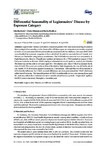Differential Seasonality of Legionnaires’ Disease by Exposure Category
Buchholz, Udo
Altmann, Doris
Brodhun, Bonita
Legionnaires’ disease (LD) shows a seasonal pattern with most cases occurring in summer.We investigate if seasonality can be observed for all three exposure categories (community-acquired(CALD), travel-associated (TALD) and healthcare-associated (HCA)). Methods: LD cases (2005–2015)were classified by exposure categories and we calculated the relative case ratio for each month fromFebruary to December using January as reference. The TALD relative case ratio was compared withflight frequencies. Results: Overall case numbers in Germany (N = 7351) peaked in August. CALDhad a curve similar to all cases. TALD displayed a bimodal curve with peaks in June/July and October.The latter was attributable to LD cases aged 60+. The relative case ratio of TALD surpassed clearlythat of CALD. The curve was similar to that of the relative flight frequencies, but was shifted by aboutone month. HCA showed no apparent seasonality. Conclusions: Although the overall seasonality inLD is heavily influenced by CALD, seasonal di erences are more pronounced for TALD which mayreflect travel behavior. The bimodal pattern of TALD is attributable to the curve among those aged60+ and may reflect their preference to travel outside school holiday periods. Heightened vigilancefor HCA cases is necessary throughout the entire year.
Dateien zu dieser Publikation
Keine Lizenzangabe

